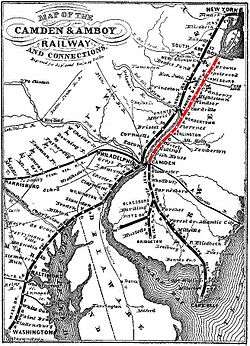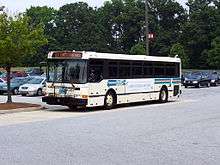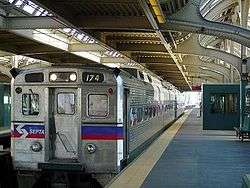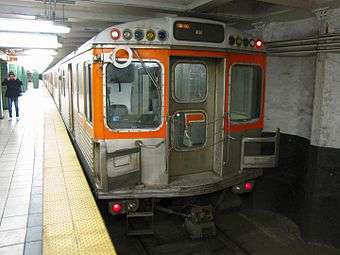Glassboro–Camden Line
Legend
| |||||||||||||||||||||||||||||||||||||||||||||||||||||||||||||||||||||||||||||||||||||||||||||||||||||||||||||||||||||||||||||||||||||||||||||
The Glassboro–Camden Line is an 18-mile (28.97 km) diesel multiple unit (DMU) light rail system planned for the southwestern part of New Jersey in the United States.[1][2] At its northern end in Camden it will connect with the River Line with which its infrastructure and vehicles will be compatible. At the northern terminus, the Walter Rand Transportation Center, paid transfers will be possible to the PATCO Speedline. The route will generally follow the right of way (ROW) of Conrail's South Jersey/Philadelphia Shared Assets Operations Vineland Secondary freight rail line which continues beyond the light rail terminus in Glassboro. The project is part of a greater plan to expand public transportation in Delaware Valley metro area.[3] It was expected to cost $1.8 billion and be completed in 2019.[4] In July 2014 the Federal Transit Administration said it would not proceed with a required environmental study because no owner or operator has been identified. While the Delaware River Port Authority is overseeing the $8.1 million environmental study, the agency has not agreed to build or run it. New Jersey Transit has agreed to fund the $8.1 million study, but has also not committed to building or running it.[5][6] As of 2016, there was no funding for the project.[7]

Route
Located within Camden County and Gloucester County the line would include fourteen stations in Camden, Gloucester City, Westville, Brooklawn, Woodbury, Woodbury Heights, Wenonah, Mantua, Sewell, Pitman, and Glassboro.
In a non-binding referendum, Wenonah citizens voted against allowing a station in town. The town council also passed such a resolution.[8]
Vineland Secondary right-of-way and freight rail

The West Jersey Railroad (WJ) was granted its charter by the state on February 5, 1853 to build a line from Camden to Cape May. The line was built with the backing of the Camden and Amboy Railroad from Camden to Glassboro, with the first 8.2 miles of the line using the abandoned ROW built by the Camden and Woodbury Railroad to Woodbury.
In 1896 the Pennsylvania Railroad (PRR) consolidated all its railroads and several smaller properties in southern New Jersey into the West Jersey and Seashore Railroad (WJ&S). In 1932, the PRR and Reading Company (RDG) merged their southern New Jersey railroad lines into one company, the Pennsylvania-Reading Seashore Lines (PRSL). The line was electrified between 1906–1949.[9] In 1968 New York Central Railroad was merged into the PRR becoming Penn Central, which was bankrupt by 1970. The last passenger train ran in 1971.[9]
The line came under the auspices of Conrail. Following the purchase and division of Conrail it was designated part of the South Jersey/Philadelphia Shared Assets Area. Known as the Vineland Secondary it is owned, operated and maintained by Conrail, the terminal railroad, for the exclusive benefit of CSX Transportation and Norfolk Southern Railway. The Vineland Secondary begins at Pavonia Yard in Camden, where the Glassboro–Camden Line would join to Glassboro, and then continue another 19 miles (30.58 km) to Millville.[10]
Regional rail and bus rapid transit
The Glassboro–Camden Line is part of a broader plan to expand a regional multimodal transportation network in Delaware Valley metro area including service across the Delaware River to Philadelphia.[3] Other elements of network would include additions and adjustments to PATCO Hi-Speed Line and Atlantic City Line and the development of new system of bus rapid transit in New Jersey. The region is served by NJT buses 400–499.
The bus rapid transit component would be developed along the heavily traveled corridor comprising I-676, Route 42, and Route 55[11] The southern end of the system would be a newly constructed park and ride in Deptford on Route 55 and an expanded one in Winslow with peak hour buses running at 10–15 minute intervals.[12] Travelling northwest the two lines would converge to pass through downtown Camden, where transfers would be possible for other components of the network, including at the Walter Rand Transportation Center.[13] They would then continue over the Benjamin Franklin Bridge, equipped with reversible or contra-flow lanes to a point near Philadelphia City Hall.[12] Depending on approval and funding, the BRT system could be completed by 2020.[12] In July 2012, NJT received $2.6 million in federal funding to advance the project.[14]
Timeline
In the early 1990s, NJT commissioned a major investment study to look examine mass transit options for the South Jersey region in Burlington, Camden, and Gloucester. A rail connection from Glassboro was proposed in the report released in 1996.[15]
- May 2009: New Jersey Governor Jon S. Corzine and the Delaware River Port Authority announce project[3]
- Spring 2010: Scoping and public meetings
- Winter 2013: Publication of draft environmental impact statement (EIS)
- Fall 2014: Final EIS and Federal Transit Administration (FTA) approval[16]
- 2014–2017: Design and permitting
- 2016–2018: Anticipated construction
- 2019: Projected start of operations
See also
- Northern Branch Corridor Project
- Light rail in New Jersey
- Bus rapid transit in New Jersey
- Delaware Valley Regional Planning Commission
References
- ↑ "Fact Sheet 2013" (PDF). Glassboro-Camden Line. DVPA & PATCO. Retrieved 2012-04-08.
- ↑ "NJ Transit Board Advances South Jersey Transportation Projects" (Press release). New Jersey Transit. December 9, 2009. Retrieved 2012-04-08.
- 1 2 3 Baldwin, Zoe (May 22, 2009). "South Jersey Transit Improvements on Tap". Tri-State Transportation Campaign. Retrieved 2013-07-20.
- ↑ Nussbaum, Paul (May 23, 2013). "Big ifs loom over Camden-Glassboro rail plan". The Philadelphia Inquirer. Retrieved 2013-07-22.
- ↑ Nussbaum, Paul (October 9, 2014). "Glassboro-Camden light-rail plan hits a snag". The Philadelphia Inquirer. Retrieved 2014-10-14.
- ↑ "Glassboro-Camden light rail still on hold with 'no timeline' while officials debate transportation funding". NJ.com. Retrieved 21 April 2016.
- ↑ "Glassboro-Camden light rail still on hold with 'no timeline' while officials debate transportation funding". NJ.com. Retrieved 21 April 2016.
- ↑ "Glassboro-Camden Line support mixed with project put on hold". NJ.com. Retrieved 21 April 2016.
- 1 2 Gambardello, Joseph A. (February 12, 1999). "The End Of The Line For A 1906 Landmark Conrail Has Decided To Tear Down The Five-story Westville Building. It Was Erected As A Power Plant.". Philadelphia Inquirer. Retrieved 2013-07-22.
Electric service on the line ended in 1949 when the state banned the use of wooden passenger cars, Schopp said. The last passenger train – a diesel-powered Budd – ran from Millville to Camden in 1971.
- ↑ "Whatever happened to Millville train service by 2019?". Press of Atlantic City. Retrieved 21 April 2016.
- ↑ "Route 55,42,767 study area map" (PDF). Alternative Analysis. southjerseytransit.co. Retrieved 2012-04-08.
- 1 2 3 Nussbaum, Paul (March 12, 2012). "NJ Transit eyes Philadelphia-South Jersey rapid-bus system". Philadelphia Enquirer. Retrieved 2012-04-08.
- ↑ "Alternatives Analysis". http://southjerseytransit.com. Retrieved 2012-04-08. External link in
|publisher=(help) - ↑ Nussbaum, Paul (July 24, 2012). "NJ Transit receives $2.6 million for rapid-bus system". Philadelphia Inquirier. Retrieved 2012-07-25.
- ↑ Dooley, Tara; Dalan, Matthew (July 26, 1996). "Nj Transit Study Explores S. Jersey Rail-line Options Burlco Officials Are Pleased With The Report. Gloucester County Residents Are Not.". Philadelphia. Retrieved 2014-01-26.
- ↑ Glassboro-Camden Line Environmental Impact Study (2012)
External links
Coordinates: 39°58′41″N 75°03′44″W / 39.9781°N 75.0623°W




